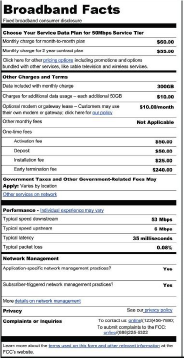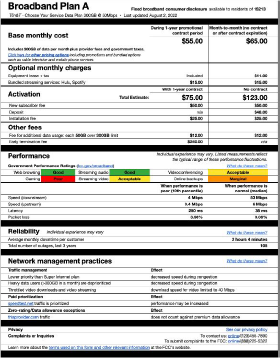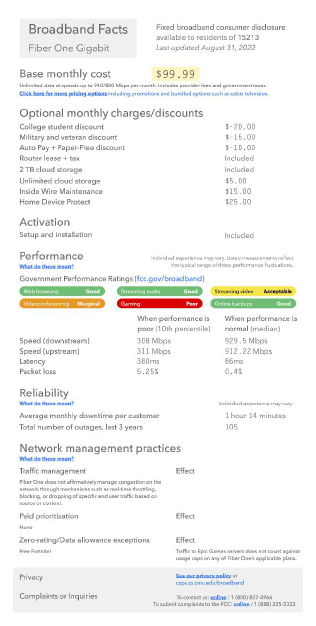A Consumer-Driven Broadband Label Design
Tuesday, October 25, 2022
Digital Beat
A Consumer-Driven Broadband Label Design

In January 2022, the Federal Communications Commission (FCC) issued a Notice of Proposed Rulemaking (NPRM), which proposed requiring internet service providers to display broadband consumer disclosure labels prominently at the point of sale. In response to the FCC’s request for comment, the CyLab Usable Privacy and Security Laboratory at Carnegie Mellon University conducted a large-scale user study to gain insight into what information is most important to US consumers when shopping for broadband internet services as well as what terminology and presentation formats make this information most understandable and useful to consumers. In addition, we examined the FCC’s proposed 2016 broadband consumer label formats and proposed our own broadband consumer disclosure label formats.
We surveyed broadband internet consumers in a two-phase online study, recruiting from a diverse pool of 32,000 consumers who had previously participated in Consumer Report’s consumer initiatives related to broadband internet. Across both survey phases we received a combined total of over 2,500 completed surveys. In the first phase we evaluated the 2016 labels to gain insights into what information was most important to consumers and what information caused confusion. We then created new label designs based on our results from the first phase. In the second phase, we compared the effectiveness of our new label designs with the 2016 labels. After analyzing our survey results, we made further revisions to our new label designs. This is a preliminary report of our findings and recommendations.
Phase 1 key findings
- Participants strongly supported the idea of broadband labels.
- Participants generally cared most about cost, speed, and reliability (a factor not included on the 2016 label) when considering a broadband plan for purchase.
- Participants were interested in metrics for both “normal” broadband performance and for times when performance is much worse than normal.
- Many participants were interested in seeing a score or grade for their plan’s performance but did not want it to replace the reporting of raw numbers.
- Participants expressed interest in using details about providers’ network management practices to avoid providers with certain practices.
- Participants struggled to compute total service cost over the span of 2, 3, or 4 years using the information on the 2016 proposed label.
- Participants generally lacked knowledge of more technical terms and performance benchmarks–such as latency, packet loss, network management practices, performance percentiles, and network congestion–but when these terms were briefly explained to them, they often showed some understanding of the concepts.
- Across all comprehension questions, non-technical participants tended to perform worse than those who self-identified as having a technical background.


The FCC’s 2016 fixed broadband label (left) was evaluated in Phase 1 and our New fixed broadband label (right) was tested in Phase 2.
Phase 2 key findings
- Our proposed (New) labels generally performed better than the 2016 labels in enabling consumer comprehension of the represented broadband plan (including performance and service costs). In addition, consumers found them easier to use and preferred their format.
- Participants wanted to know the total cost of their internet plan and disliked any ambiguity; participants also expressed a desire for in-depth cost explanations, for taxes to be included as part of the label, and for some sense of plan service area.
- Participants requested information about network reliability, when and by how much the listed performance metrics could drop during peak times, and explanations for technical terms.
- Participants expressed interest in having both performance numbers and suitability ratings included on a label.
- Participants generally wanted to see a lot of information on the label but also wanted a label that would be simple to understand and compare across plans.
- Generally, we saw slightly lower comprehension among non-technical participants than those who self-identified as having a technical background, and non-technical participants were slightly less likely to find the labels easy to use. These modest differences showed up in both the 2016 and New labels.
Recommendations
- Broadband labels should include a range of information valued by consumers but should highlight the information they value most, including information on cost, speed, and reliability.
- Broadband labels should balance the needs of consumers who value simplicity and conciseness with those who value detailed information. This can be achieved with a standardized label design with links to definitions of terms maintained by the FCC in a format conducive to comparing multiple plans. A layered label design with a summary and full version may help address the needs of a wider range of consumers.
- Broadband service providers should be required to deposit detailed plan information in a standardized computer-readable form in a publicly accessible database to enable third parties to generate customized labels for consumers and offer comparison shopping tools, quality of experience or suitability ratings, and other value-added services.
- Non-optional costs should be bundled into a total cost where possible, including taxes, to make it easy for consumers to determine how much they will need to pay.
- Performance metrics should be included for downstream speed, upstream speed, latency, and packet loss in both normal and poor performance times.
- Broadband labels should include some measure of reliability, addressing consumer interest in information about outages and downtime.
- All data rate units should be kept consistent (e.g. all broadband providers would express throughputs in Mbps and latencies in ms).
- Network management practices should be enumerated on the label in standard groups and accompanied by a standardized glossary with definitions and examples that explain these terms to consumers.
- Labels and accompanying data should be localized so that consumers can readily compare plan details—including total costs, performance at both normal and busy times, reliability, and network management practices—for a particular geographic location.
A Consumer-Driven Broadband Label Design
Our study concludes with a proposal for a broadband label design that takes into account participant feedback on both the 2016 and New label designs we tested. To help balance the need for both simplicity and detail, we propose a layered label design with both summary and detailed views, shown below.

The summary layer of our prototype layered design for a consumer broadband label.

The detailed layer of our prototype layered design for a consumer broadband label.
Dr. Jon Peha is a professor of electrical & computer engineering and of engineering & public policy at Carnegie Mellon University and former chief technologist at the Federal Communications Commission.
The Benton Institute for Broadband & Society is a non-profit organization dedicated to ensuring that all people in the U.S. have access to competitive, High-Performance Broadband regardless of where they live or who they are. We believe communication policy - rooted in the values of access, equity, and diversity - has the power to deliver new opportunities and strengthen communities.
© Benton Institute for Broadband & Society 2022. Redistribution of this email publication - both internally and externally - is encouraged if it includes this copyright statement.
For subscribe/unsubscribe info, please email headlinesATbentonDOTorg






